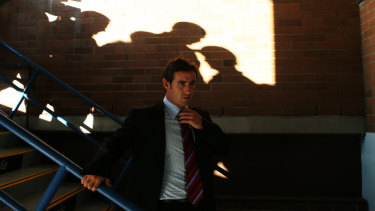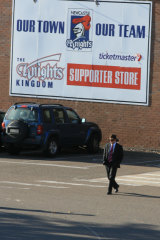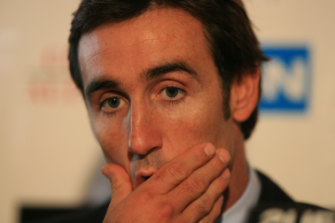From the Archives: The greatest says goodbye

Andrew Johns walked away while he still could, told to quit or face a catastrophic injury. He retired with his legend assured – a master on the field, a larrikin for the ages off it.

A reluctant farewell . . . pursued to the end by a media pack, Andrew Johns leaves his news conference at the Knights stadium on April 10, 2007.Credit:Tim Clayton
First published in the Sydney Morning Herald on April 11, 2007
Asking a player to cover Andrew Johns on the field was akin to expecting a sheepdog to catch mice.
It wasn't that "Joey" was blindingly fast or eye-poppingly evasive. He simply out-thought everyone else.
He played with a clock inside his head, slowing the game down, or speeding it up; keeping the play tight, then letting the ball move; passing inside, then directing it out.
Advertisement
Stand the defence up and "Joey" would kick behind them; stand back and he would kick short.

Andrew Johns head to his press conference at the Knights stadium to announce his retirement.Credit:Tim Clayton
Like Don Bradman, all this skill was honed in backyard games. "Andrew and Matthew destroyed all my shrubs, broke the fibro wall of the garage and up-ended their trampoline, using it as a target for kicking practice," his mother, Gayle, once told me of what would become perhaps the most creative brother act since the Ringlings.
Johns's superior skill made him the best player of his generation and his all-round game renders him the sui generis of the code – one of a kind, even amongst the Immortals he will almost certainly join.
Unlike John Raper, who wasn't expected to kick, or Reg Gasnier, who was not required to make 30 tackles, or Clive Churchill, who wasn't asked to gain meterage from dummy half, the demands of the modern game meant Johns had to be both versatile and have a high work rate.
On the eve of his recall to the NSW State of Origin team in 2005, he was the only player in the NRL who regularly received a tick in all 40 categories of the matrix of skills coaches observe.
But his versatility cost him personal honours.
His recall Origin game in 2005 – when he rescued NSW – was only his fifth as an 80-minute halfback.
Representative coaches, recognising Joey's ability as a human Scrabble blank, played him hooker, knowing he could defend like a forward.
Injuries also cost him Test matches, the statistic that usually embroiders the legends.
Of the 35 Tests for which he was eligible until his international retirement, he played in only 18.
He was cursed by their timing: most of his injuries were late season, just before the majority of Tests are played.
"In the late 1990s I had groin operations, then in 2002, 2003, 2004 I had back, neck and knee injuries," Johns once told me.
"Those injuries robbed me of a few Tests and it's something I find disappointing."
But the fact that he carried more injuries than the medicart reflects his huge commitment to his club, the Knights.
From the time he became a regular first-grader with Newcastle in 1994, until his last Origin match, he played in 75 per cent of the Knights' matches.

The best player of his generation… Andrew Johns in reflective mood.Credit:Tim Clayton
[contf] [contfnew] 
Australian Breaking News Headlines
[contfnewc] [contfnewc]




